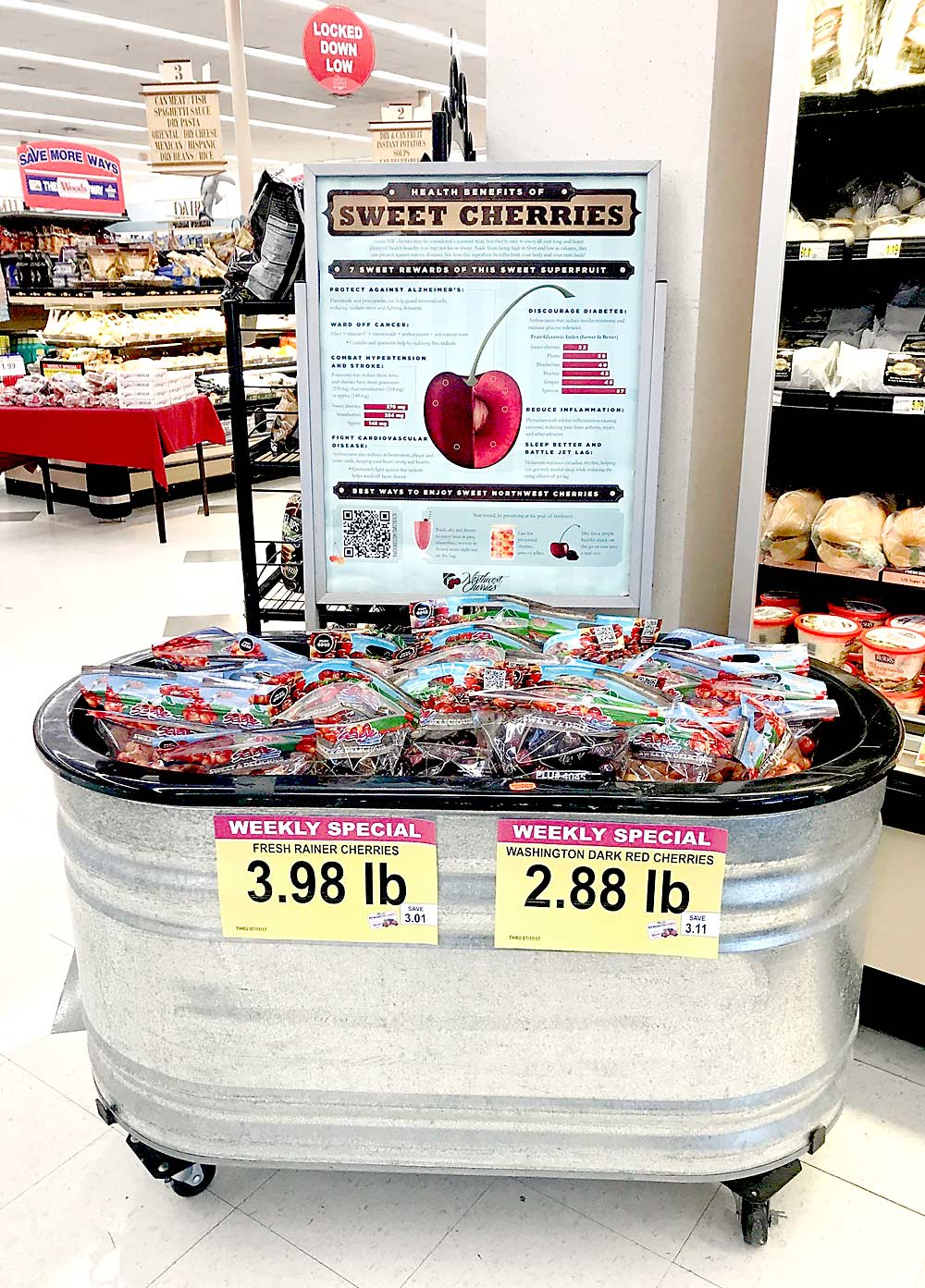Here we are in April 2020, everything is as it should be in our orchards: The current buildup of growing degree days could not be more positive and the spread between early and late orchards is optimal. Unfortunately, what is going on in the rest of the world that has our attention and focus this year.

Over the past two years, the Northwest cherry industry has had to deal with 60 percent tariffs in its leading offshore market, China. This has had a downward pricing impact on grower returns while cutting the volume in our best export market by half. This has put further price pressure on both domestic and export markets.
At this time last year, I said that we would endure another unpredictable year in the stone fruit business. As of today, I would gladly take the market disruptions I was seeing at this time last year as our largest obstacle to success.
Currently, we are all living in a world that has seemingly come undone. The explosion of a deadly new coronavirus has wreaked havoc across the globe and the financial markets. Today, I am writing this from my home office, as a result of a government-mandated quarantine that has come out of a truly frightening global pandemic. The normal challenges of setting up the world market for our cherries have gone out the window as the pandemic peaks here in the United States.
The question I have asked myself thousands of times over the last month: How do we reach consumers when they are holed up in their homes and we have a product where 70 percent of our sales are made on impulse at the grocery store?
In a single month the world has been changed, and how we go to market must change with it. Currently, our team is conducting retail and importer meetings via online forums like “GoToMeeting” and “Zoom.” I have found these meetings to be both effective and time efficient.
I heard a variety of challenges from the retail side of the business: consumers buying more staples like apples, potatoes and bananas; online orders and remote pickup surging across the globe; and consumers changing their focus to staying home and staying healthy by avoiding public gatherings like barbecues and picnics. We are exploring every opportunity to promote our fruit online at retailer online order landing pages.
We continue to educate retailers through online platforms that our growers require actual live people working in our orchards and packing facilities — which seems to get more expensive every year. Workers in orchards and fields cannot telecommute. Our orchard labor cannot fall back on computers, phones, webcams and Zoom to do the actual harvesting of our crop. Today’s labor is cost-intensive, and the trade needs to understand this.
As tree fruit growers, we are always in a state of change and renewal. We are being force-fed a market situation that we have never seen before. As always, we will change to make this season work.
There is some good news in the murky world that we are living in: We still have two months before we hit volume on our harvest. There is still time for our infection curve to flatten and bring our world back to some type of normalcy.
We have been in continuing conversations with retailers and importers in China and Korea — two countries that were first hit by COVID-19. They report that as their infection curve has been greatly reduced, more people are going out to shop in stores and eat in restaurants, and produce sales have picked back up significantly in the past two weeks.
Many domestic retailers say that they will count on cherries to help make up for some of the lost dollars of February and March. They believe that people will look forward to summer specialty items like berries and cherries. They are open to putting cherries up-front in the stores and on the online order landing pages.
At this point, I would like you to hear some of the preseason strategy from the team in charge of running industry promotion programs, James Michael and Keith Hu.
James Michael – Domestic program strategy for 2020:
Marketing the fresh cherry crop in the domestic market is, in a good year, a complicated process. Akin to building an arch, all of the stones have to be arranged in the right order at the right time so the keystone cherry crop can be dropped in at the last moment to make the whole process a success.

In the face of a pandemic shifting how North Americans move and shop for groceries, there are no longer any construction plans. However, the shift toward online shopping has been on the horizon and the Northwest Cherry Growers (NWCG) have been carefully probing this avenue of sales and marketing over the past few seasons.
With careful execution, there are a number of positive factors surrounding our fruit that suggest there’s no reason not to expect a successful season ahead.
In the past several years, both the North American (not including Mexico) and export teams have conducted research examining the impulse versus planned sales rates of fresh cherries. Averaging across three studies, we found that seven out of 10 people who buy a bag of Northwest cherries make that decision when they see them. This high impulse rate, plus their top dollar-earning potential for retailers, helps our promotion teams leverage cherries into prime locations throughout the store. However, with decreasing foot traffic in every store and the possibility of increasing shrink (loss) from fewer purchases, it will be key to get retailers to maintain these eye-catching displays.
The pandemic-driven massive growth we are seeing in online grocery shopping takes that visibility issue and inflates it. Fortunately, communicating information and driving impulse opportunities is core to today’s digital world. Tying those messages and impulse drivers to a point-of-sale opportunity, however, is a much greater challenge. Almost every retailer has its own unique online consumer sales system, making universal advertising hard to execute. And while each of those retailers typically has a few different ways to reach their customers online, they try not to overwhelm them with messaging or ads. That makes those digital spaces perhaps the hottest real estate in the country right now. Much of that space was already contracted out months in advance, and now every brand and producer in the country is trying to get one of those spots. Fortunately, NWCG category research and retailers’ own observations are on our side.
Nothing earns more dollars for a produce department in July than cherries, and they’re one of the top earners all summer. Getting cherries in front of their customers online and in stores this June will be a huge opportunity for a retailer to help staunch the margins they’ve been bleeding since the stay-at-home orders started rolling out across the country.

Shoppers who’ve been living on apples, bananas and grapes while spring slowly changed to summer outside their windows will, history suggests, be ready for a taste of summer. And our fresh cherries, high in both vitamin C and anti-inflammatory properties, are well suited to deliver. It’s going to take collaboration with retailers to ensure that in-store shoppers, as well as the large number of new online shoppers, will find our cherries front and center, though.
Unfortunately, there is no single, easy pathway to success in this time of chaos, but fortunately, growers, sales desks and retail buyers alike all want to reach the same destination: a successful cherry season and a full crop sold.
Keith Hu – Export program strategy for 2020:
As the current pandemic surges across the globe, the challenge of running effective promotion programs has increased significantly.

However, the situation has improved for a few markets. Just a few weeks ago, conditions in both China and South Korea looked bleak. Cities were in complete lockdown, people were not allowed to leave their homes, infected cases and the death toll were increasing dramatically by the day. Nevertheless, recently both China and South Korea have started to loosen their movement restrictions. Restaurants and retail shops are reopening, people are going back to work, older kids are returning to school. However, lots of precautionary measures were implemented.
In the past weeks, I have had many virtual meetings with our key business partners in China, South Korea, Mexico and other markets located in the Asia Pacific (APAC) region. Some meetings were pretty gloomy, but meetings with supermarket buyers from China and South Korea were pretty encouraging. Buyers all mentioned sales of fresh produce are up, but they need popular items like Northwest cherries to help ease the pain of lost sales revenue.
Taiwan, NWCG’s third largest overseas market, is calmly weathering the pandemic. Taiwan’s coronavirus response is among the best globally, due to early response. Impacts on daily life are at a minimum. Shoppers continue to go to supermarkets and traditional markets. My team in Taiwan and I are currently finalizing the 2020 campaign.
Unfortunately, COVID-19 cases are on the rise in the Southeast Asia region. Thailand, Singapore and Malaysia all have implemented some kind of movement restrictions.
Vietnam, the most important NWCG market in the Southeast Asia region, is handling the pandemic quite well. The Vietnamese government has set up many quarantine camps throughout the country. The good news is that the supermarket business is doing fine. Restaurants and retail shops are still open. Although in-store foot traffic has slowed, overall produce sales have remained close to normal volumes.
Retailers from all markets reported an increase in online sales and home delivery service. This is where the opportunity is for 2020. I’m planning to work with key supermarkets to promote our cherries heavily on their online shopping websites and work with large e-commerce companies to generate Northwest Cherries brand and product awareness. Markets that have the pandemic under control will be targeted for retail promotions at the store level.
Lastly, the coming season could be a very “interesting” year for the foreign markets. There are many uncertainties and obstacles. I think we could see some markets perform very well, while others struggle. On a positive note, China has lowered the import duty on Northwest cherries to
25 percent, from 60 percent in 2019.
—by B.J. Thurlby






Leave A Comment